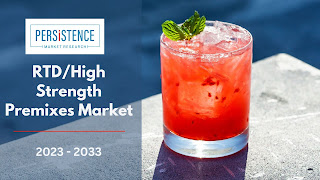- Get link
- X
- Other Apps
- Get link
- X
- Other Apps
Ready-to-drink (RTD) beverages and high-strength premixes have carved out a significant niche in the global beverage market. The convenience, portability, and diverse flavor profiles of these products have attracted consumers seeking quick refreshment solutions. With the beverage industry witnessing dynamic shifts in consumer preferences and lifestyle choices, understanding the market size and growth projections of RTD/high-strength premixes becomes imperative for stakeholders. In this article, we delve into the market insights, analyzing the current landscape, drivers, challenges, and future trajectories of this burgeoning sector.
The RTD/High Strength Premixes market is poised for substantial growth, driven by evolving consumer preferences for convenient and innovative alcoholic beverages. Ready-to-Drink (RTD) and High Strength Premixes offer consumers pre-mixed cocktails, spirits, and flavored alcoholic beverages in convenient packaging, catering to the demand for on-the-go consumption and unique flavor experiences.
Current Market Landscape:
The RTD/high-strength premixes market has witnessed remarkable growth in recent years, fueled by changing consumer behaviors, urbanization, and increasing disposable incomes. These products encompass a wide range of alcoholic and non-alcoholic beverages, including cocktails, spirits, energy drinks, and flavored water, among others. According to Persistence Market Research's projections, the market for RTD/high strength premixes can be expected to expand at a value based CAGR of 4.4% and show an increase in revenue from US$ 5,039.4 Mn to around US$ 7,751.5 Mn by 2033.
Key Drivers of Growth:
Several factors contribute to the burgeoning demand for RTD/high-strength premixes:
Convenience: The fast-paced lifestyle of modern consumers emphasizes convenience and time-saving solutions. RTD beverages offer instant gratification, eliminating the need for preparation or mixing.
Changing Consumer Preferences: Millennials and Gen Z consumers, in particular, are inclined towards experiential consumption, seeking innovative flavors and unique beverage experiences. RTD/high-strength premixes cater to this demand with a plethora of flavor options and trendy formulations.
Premiumization Trend: The premiumization of beverages, driven by a growing preference for high-quality and artisanal products, has propelled the demand for upscale RTD cocktails and spirits. Consumers are willing to pay a premium for products that offer superior taste, quality ingredients, and aesthetic appeal.
Health and Wellness Focus: Despite the indulgent nature of some RTD beverages, there is a rising demand for healthier options. Manufacturers are responding by introducing low-calorie, natural ingredient-based, and functional RTD products, catering to health-conscious consumers.
Expanding Distribution Channels: The proliferation of e-commerce platforms, convenience stores, and specialty retailers has widened the reach of RTD/high-strength premixes, making them more accessible to consumers across various demographics and geographic regions.
Read More: https://www.persistencemarketresearch.com/market-research/rtd-high-strength-premixes-market.asp
Challenges and Opportunities:
While the RTD/high-strength premixes market presents lucrative opportunities, it also faces several challenges:
Regulatory Hurdles: The alcoholic beverage sector is subject to stringent regulations concerning labeling, advertising, and distribution. Compliance with varying regulatory frameworks across different markets poses challenges for manufacturers and may hinder market expansion.
Intense Competition: The market is highly competitive, characterized by the presence of established players as well as new entrants vying for market share. Differentiation through product innovation, branding, and marketing strategies is essential to stand out amidst competition.
Supply Chain Disruptions: The COVID-19 pandemic exposed vulnerabilities in global supply chains, impacting the production and distribution of RTD beverages. Manufacturers need to enhance supply chain resilience and flexibility to mitigate future disruptions.
Sustainability Concerns: With growing environmental awareness, consumers are increasingly scrutinizing the sustainability practices of beverage companies. Sustainable packaging, eco-friendly production methods, and responsible sourcing of ingredients are becoming key differentiators in the market.
Despite these challenges, the RTD/high-strength premixes market presents promising opportunities for growth:
Innovation and Product Diversification: Continued innovation in flavors, formulations, and packaging formats will enable companies to cater to evolving consumer preferences and tap into new market segments.
Strategic Partnerships and Collaborations: Collaborations between beverage companies, retailers, and technology providers can unlock synergies, enhance distribution networks, and drive market penetration.
Digital Marketing and Brand Engagement: Leveraging digital platforms and social media channels for targeted marketing campaigns and consumer engagement initiatives can foster brand loyalty and increase market visibility.
Geographic Expansion: Emerging markets, particularly in Asia-Pacific and Latin America, present untapped opportunities for RTD/high-strength premixes. Strategic expansion into these regions can fuel revenue growth and diversify market presence.
Growth Projections:
Analysts anticipate robust growth in the RTD/high-strength premixes market over the forecast period, driven by the aforementioned factors. The market is poised to witness a surge in demand for premium and functional beverages, innovative packaging solutions, and sustainable offerings. Moreover, the rising popularity of at-home consumption and social gatherings is expected to further bolster market growth.
The RTD/high-strength premixes market represents a dynamic and evolving landscape, shaped by changing consumer preferences, market trends, and regulatory dynamics. Despite challenges, the market offers abundant opportunities for manufacturers, retailers, and investors to capitalize on the growing demand for convenient, flavorful, and experiential beverages. By staying abreast of market insights, embracing innovation, and forging strategic partnerships, stakeholders can position themselves for success in this thriving sector.
Follow Us: LinkedIn | Medium | Twitter
About Persistence Market Research:
Business intelligence is the foundation of every business model employed by Persistence Market Research. Multi-dimensional sources are being put to work, which include big data, customer experience analytics, and real-time data collection. Thus, working on “micros” by Persistence Market Research helps companies overcome their “macro” business challenges.
Persistence Market Research is always way ahead of its time. In other words, it tables market solutions by stepping into the companies’/clients’ shoes much before they themselves have a sneak pick into the market. The pro-active approach followed by experts at Persistence Market Research helps companies/clients lay their hands on techno-commercial insights beforehand, so that the subsequent course of action could be simplified on their part.
Contact Us:
Persistence Market Research
G04 Golden Mile House,
Clayponds Lane, Brentford, London,
TW8 0GU UK
Email: sales@persistencemarketresearch.com
Web: https://www.persistencemarketresearch.com
- Get link
- X
- Other Apps

Comments
Post a Comment